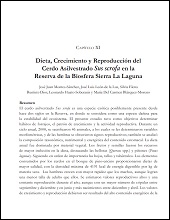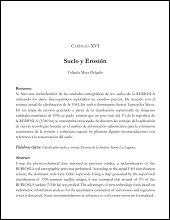Dieta, Crecimiento y Reproducción del Cerdo Asilvestrado Sus scrofa en la Reserva de la Biosfera Sierra La Laguna
Autor
JUAN JOSE MONTES SANCHEZ
JOSE LUIS LEON DE LA LUZ
SILVIA ELENA BUNTINX DIOS
Leonardo Huato Soberanis
María del Cármen Blázquez Moreno
Metadatos
Mostrar el registro completo del ítemResumen
"El cerdo asilvestrado Sus scrofa es una especie exótica posiblemente presente desde hace dos siglos en la Reserva, en donde se considera como una especie dañina para la estabilidad del ecosistema. El presente estudio tuvo como objetivos determinar hábitos de forrajeo, el patrón de crecimiento y la actividad reproductiva. Durante un ciclo anual, 2008, se sacrificaron 46 animales, a los cuales se les determinaron variables morfométricas, y de las hembras se obtuvieron signos reproductivos; también se analizó la composición taxonómica, nutrimental y energética del contenido estomacal. La dieta anual fue dominada por material vegetal. Los frutos y semillas fueron los recursos de mayor inclusión en la dieta, destacando las bellotas (Quercus spp.) y piñones (Pinus lagunae). Siguiendo en orden de importancia las hojas, tallos y tubérculos. Los elementos consumidos por los cerdos en el bosque de pino-encino proporcionaron dietas de mayor calidad, con la densidad máxima de 4191 kcal de energía digestible por kg de materia seca. Las hembras crecen con mayor rapidez que los machos, aunque logran una menor talla de adulto que ellos. Se estimaron valores reproductivos altos y una contante reproducción durante el año, aunque con un mayor número de cópulas entre septiembre y diciembre y en junio y más nacimientos entre diciembre y abril. Los valores de crecimiento y reproducción debieron ser resultado del alto contenido energético de la ingesta, lo cual pueden traer el incremento de la población, sin embargo, es posible que esto sea regulado por la alta mortalidad de las crías lactantes." "The feral pig Sus scrofa is an exotic species introduced to the Reserve, probably two centuries ago, and apparently has a high impact on the ecological stability of the Reserve. This study was focused on the foraging behavior, reproductive capacity, and individual growth of the feral pigs. In the 2008 annual cycle, forty six pigs were collected. Their morphometric features were measured, reproductive features of females were examined, and stomach contents were analyzed to determinate the taxonomic composition and nutrient and energetic values. Stomach content analysis showed that their diet is largely plant matter. Fruits and seeds were the most common plant components, mainly acorns (Quercus spp.) and pine nuts (Pinus lagunae); following in order for leaves, stems, and tubers. The oak-pine woodland diet provided higher quality diets, whit the maximum density of 4191 kcal of digestible energy per kg of dry matter. Females grow faster than males during their first two years. As adults, males are taller. High breeding values were estimated and the pigs reproduce during all year, but there are more copulation from September through December and in June, and births mainly occur from December through April. Fast growth and high breeding are likely related to the energy content of the diet, sufficient to lead to a population increase. However, this is not the case because mortality is high among lactating piglets."
Colecciones
Ítems relacionados
Mostrando ítems relacionados por Título, autor o materia.
-
PROMOCIÓN DEL PERIFITON PARA EL CULTIVO DE CAMARÓN BLANCO: HACIA UNA ACUICULTURA ECOLÓGICA
DOMENICO VOLTOLINA LOBINA; JUAN MANUEL AUDELO NARANJO; MARIA DEL ROSARIO PACHECO MARGES -
Suelo y Erosión
YOLANDA LOURDES MAYA DELGADO


